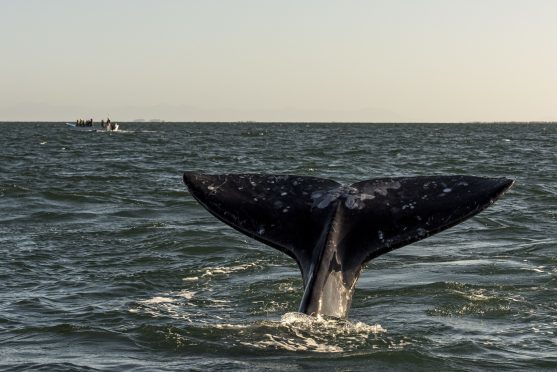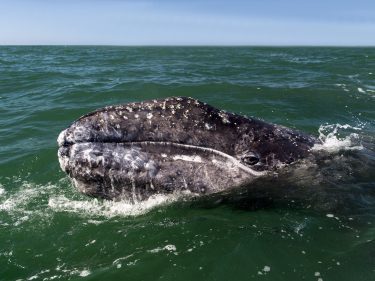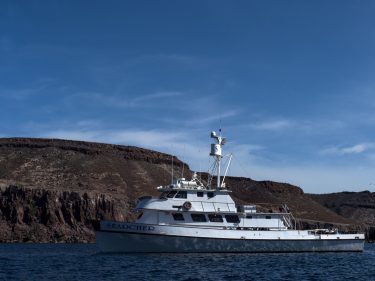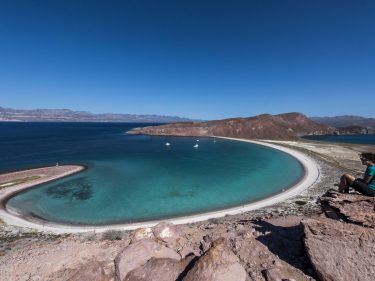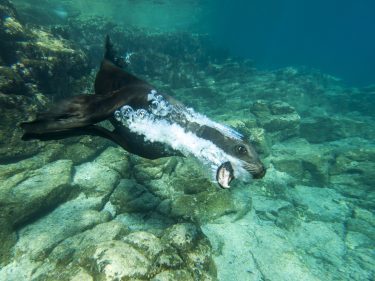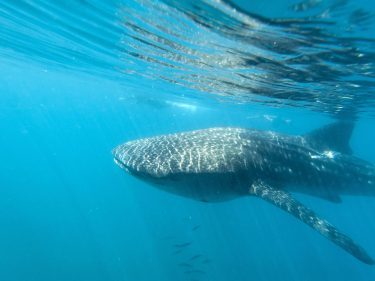Ahead of World Oceans Day on June 8, Sarah Marshall visits Mexico’s Baja Peninsula to explore the underwater wonders of our blue planet
Like most women in their late 30s, I’ve kissed a lot of frogs in my time and found a few princes along the way, but to date, I’ve never planted my lips on a marine mammal.
Nor do I want to.
“I’ve just snogged a whale!” squeals Lynn, an excited British tourist who clearly thinks differently.
To look at, gray whales aren’t the most attractive creatures; covered in barnacles and sea lice they host more external parasites than any other cetacean. But here, in Mexico’s San Ignacio Lagoon, the desire to touch, pat or even cuddle these 30 tonne animals is compulsive.
Generally speaking, I’m not a fan of “petting” wildlife, but on this rare occasion, the invited interaction does feel consensual – although perhaps a snog is a touch too far.
“Maybe it’s wrong to anthropomorphise, but I like to think they enjoy the contact,” says Ian Rowlands, conservation campaigner and co-founder of WhaleFest, the world’s biggest celebration of cetaceans.
On June 8, World Oceans Day aims to raise awareness about the importance of our blue planet, so I’ve joined Ian on an 11-night trip to one of the world’s best-protected marine wildlife havens.
Described by oceanographer Jacques Cousteau as “the world’s aquarium” and popularised by author John Steinbeck in his 1951 seafaring travelogue, the Sea of Cortez – which separates the narrow Baja Peninsula from Mexico’s mainland – is a playground for fluking blue whales, breaching humpbacks and 43 other types of cetacean.
The Searcher, a 95ft tourist vessel built in 1970 and sleeping 24 passengers, is one of only two boats with a complete set of permits to visit marine reserves along both coastlines of the peninsula.
Owner Art Taylor recalls being part of the Seventies movement towards saving whales, soundtracked by Roger Payne’s cult vocalisation album Songs Of The Humpback Whale, which sold 10million copies – the greatest single pressing of any record ever.
Around the same time, fishermen working in lagoons along the Baja Peninsula were whispering stories of curious, friendly gray whales. A new era in whale watching tourism dawned with tours run exclusively by local communities.
Disembarking The Searcher, we board one of 16 Pangas licensed to operate in San Ignacio Lagoon.
Inquisitive gray whales spy hop inches away from us, their barnacles glinting in the sunshine like diamond-encrusted tiaras.
Amidst sociable tail flukes and less-than-sociable blows, the watery shadows of six mammals merge below the boat. In a scene reminiscent of the first day at the school gates, pushy mothers propel their timid young calves into the spotlight.
Every year, from December to April, grays gather here to breed and train their young, before migrating more than 5,000 miles north to the Bering, Chukchi and Beaufort Seas.
We’re visiting at the end of the season, when only a few playful mothers and calves remain. Arguably, though, interactions are much more intense.
Touching the slippery sea monsters feels oddly like stroking a plump, tender aubergine, but the sensation of connecting with these deep-sea denizens leaves me choked and speechless.
The wife of former Mexican President Ernesto Zedillo clearly felt the same when she kissed a whale. The tender moment was enough to convince Zedillo to veto a proposed 80million dollar project by Mitsubishi to build a salt factory in the lagoon.
Now, the Unesco World Heritage Site is part of the Vizcaino Biosphere Reserve, one of the largest protected areas in Latin America.
But gray whales are not the only beneficiaries.
On the first day of our trip along the Pacific coast, after setting sail from San Diego, we spot an impressive 10 blue whales, hundreds of bow-riding bottlenose dolphins and mobula rays flipping like hot pancakes.
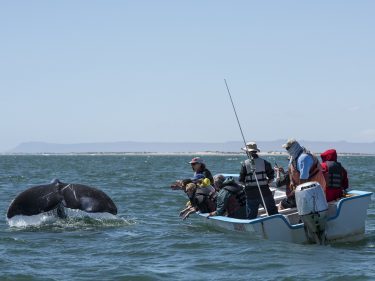
“I’ve never seen anything like this before,” admitted The Searcher’s erudite resident naturalist Rob Nawojchik, who divides his downtime between digesting scientific journals and blue whale-sized portions of ice cream.
The peninsula is rich with stories of animals brought back from the brink of extinction, including the rare Guadalupe fur seal. In 1954, only 14 individuals remained on Guadalupe island, but now a second colony is thriving on San Benito island, where we embark on a morning hike.
Sidestepping seabird burrows and prickly balls of chollo cacti, we climb a dusty, sun-parched ravine, flanked by thirsty agave plants coiled into submission. From a plateau, we look down at a haul out of honking elephant seals and spy Guadalupe fur seals frolicking in the clear bottle green water.
Only a handful of fishermen temporarily set up shacks here – quite a contrast to busy city La Paz, one of our next stops.
Dealing with crowds now would be harrowing, but fortunately, there’s no need to go ashore. Our quarry lies in the sheltered bay.
Whale shark swimming tours have been responsibly run here for the past decade, and luckily, we manage to catch the tail end of the season. With enough of the world’s largest fish to go around, we’re privileged to snorkel in a small group of eight.
Our co-operative superstar whale shark glides steadily alongside us for 40 minutes, trailing a “fan base” of clingy remora fish. His A-star aura literally bowls me over when 1.5m of filter-feeding jaw switches in my direction.
It’s the first of many remarkable underwater encounters: I watch guineafowl puffers ruffle their gills in a Mexican wave as garden eels waft like blades of grass in the underwater breeze. I’m immersed in a thousand-strong shoal of silvery jacks; and in the protected waters of Los Islotes, I perform aquatic somersaults with sea lions.
Our land excursions reward us with equally impressive sights.
Shortly after sunrise, when the wind-chiselled sandstone rocks are still glowing red, we land at Santa Catalina island, an arid, cactus-strewn landscape providing the perfect cover for snakes, lizards and outlaws.
Chirping verdin birds perch atop the slender fingers of cardons, poking through a veil of morning mist, while on the ground, endemic rattleless rattlesnakes (yes, there is such a thing!) hide between the writhing tentacles of galloping cacti.
The sense of solitude is almost suffocating. But, as I similarly discover during hours spent fruitlessly whale watching, it’s a welcome emptiness rarely experienced in our busy, everyday lives.
Due possibly to El Nino and partly bad luck, we see very few whales in the Sea of Cortez. But those we do encounter put on a memorable show. One humpback floats remarkably close to the surface, his gleaming white pectorals fanned out as if in flight, leading Captain Aaron to dub him a Sea Angel.
Marine mammals have frequented these waters for centuries, so I’ve no doubt they’ll soon return. Scientists have even identified whale rock paintings dating between 2000 and 8000 years in the mountain ranges of Baja, with some documented on San Francisco, one of our final landing sites.
Heading to the highest point, I climb along the island’s emaciated spine, where mineral-rich cliffs fold like verdant hills and views dip down to a sparkling horseshoe bay.
A cairn attracts me to a rock where I find a weather beaten sketchbook and a tin of pencils stashed into a crevice.
Playing along with the game, I contribute my own drawing to “Emily Pickering’s Journal”. It’s my modern day take on those ancient rock paintings, documenting creatures I hope will still be around for thousands of years to come.
TRAVEL FACTS
Sarah Marshall was a guest of Wildlife Worldwide (www.wildlifeworldwide.com; 01962 302 086) who offers a 14-day Ocean Giants of Baja California voyage around Baja California from £4,895 per person, based on two sharing, including return international flights from London, transfers, 12 nights on board The Searcher with all meals, one night in San Diego, guided activities and the services of the boat crew and expert naturalist guides.
